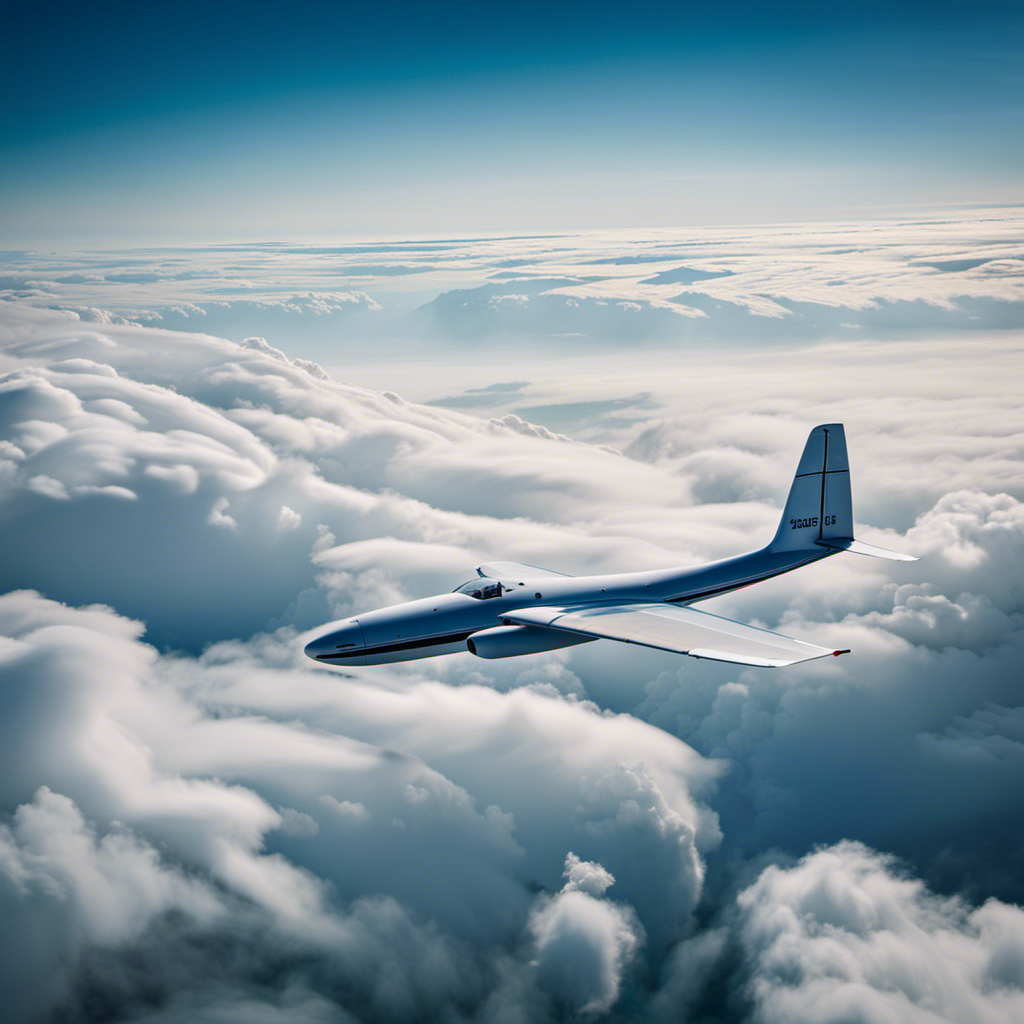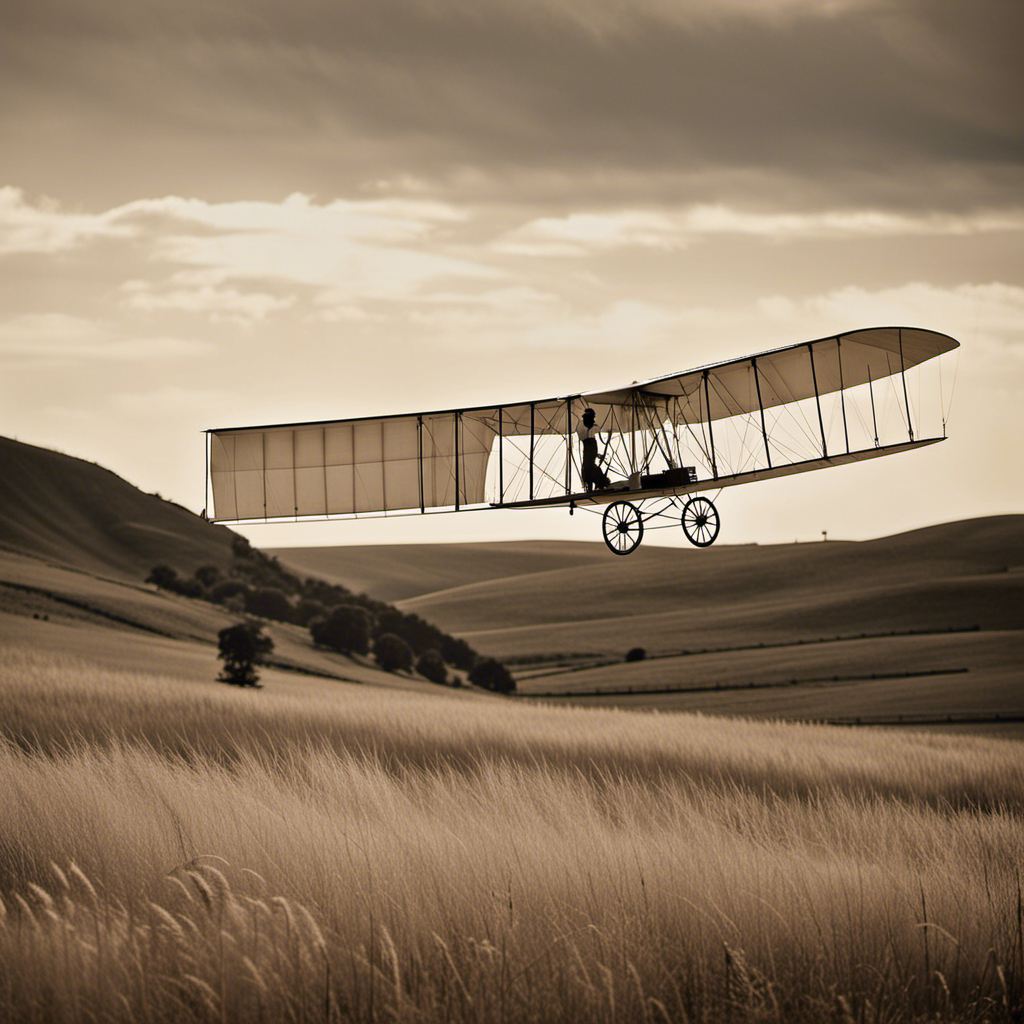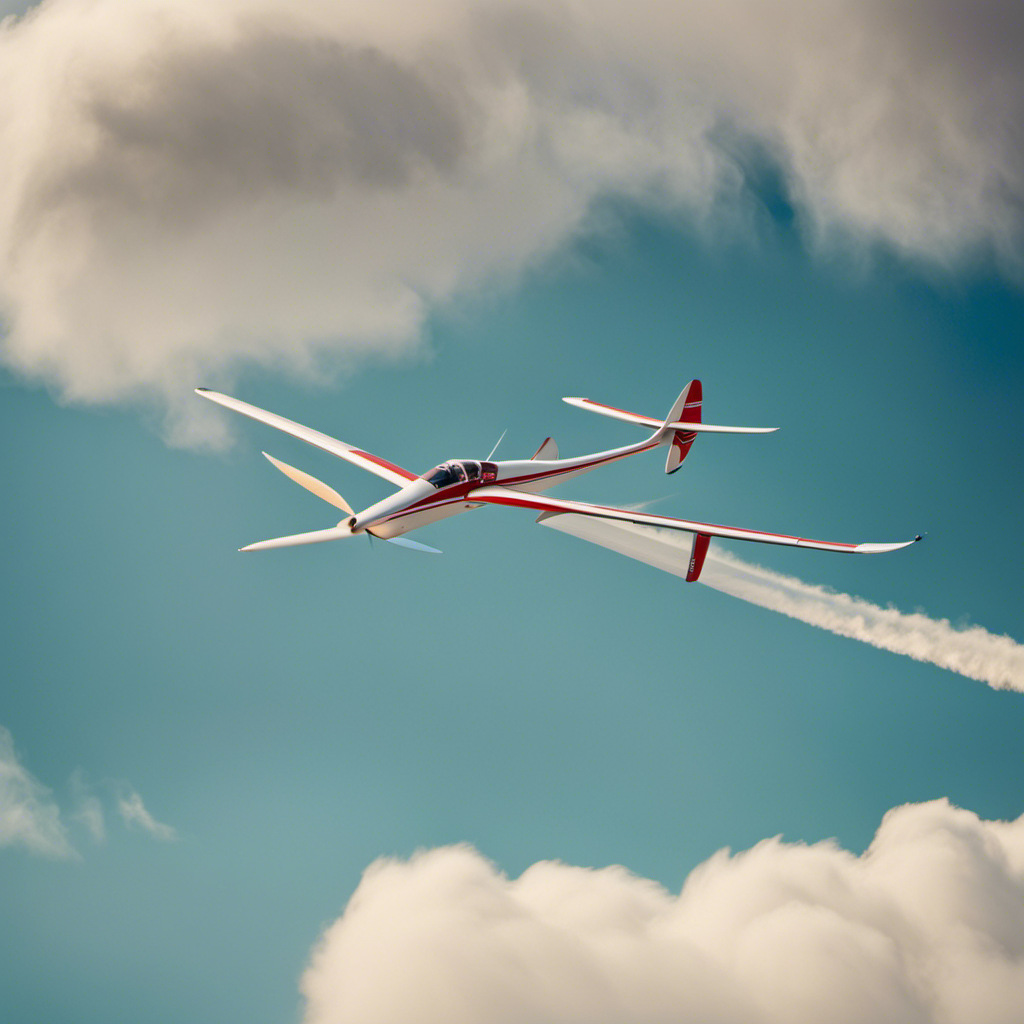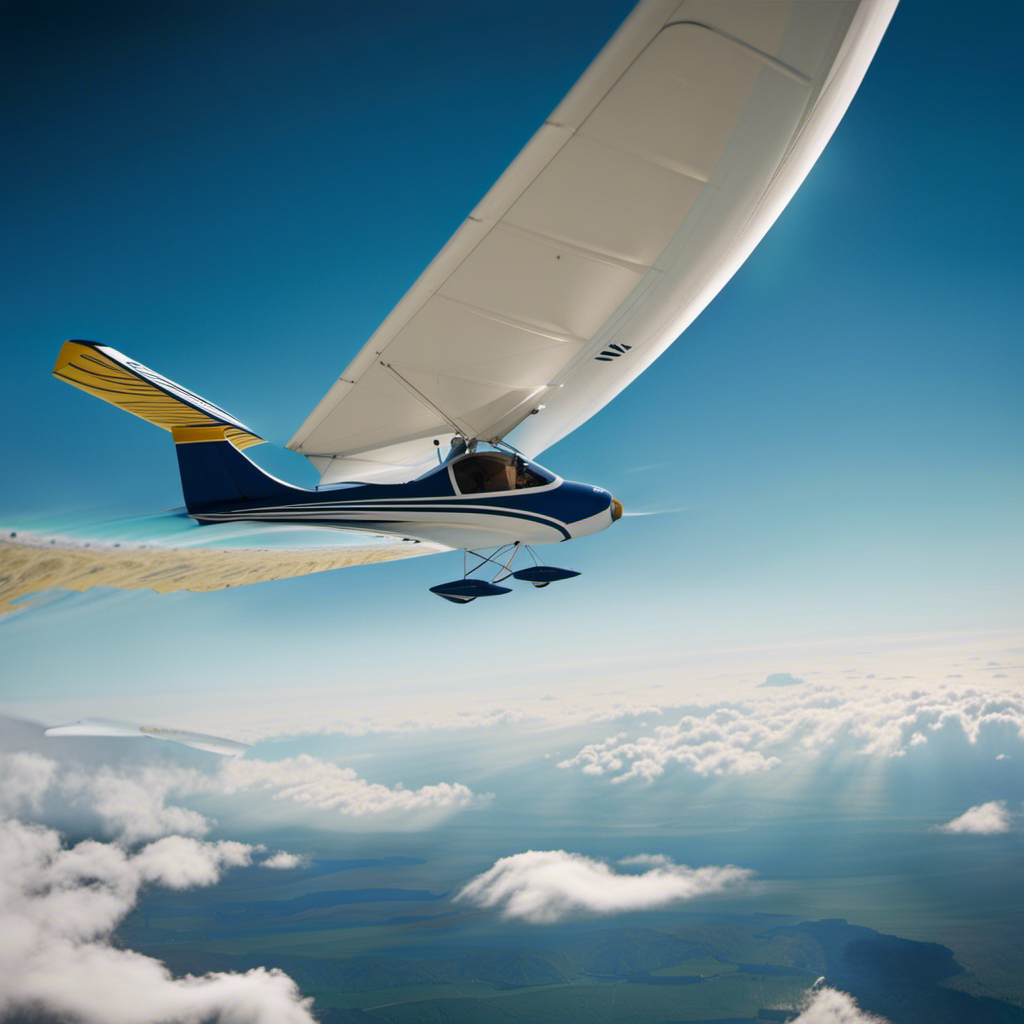Imagine yourself soaring through the sky, weightless like a feather, powered solely by the soft breeze beneath your wings. That sensation closely mirrors the experience of gliding through the air.
As I strapped myself into the cockpit and felt the rush of adrenaline before takeoff, I knew I was in for an experience like no other.
In this article, I will take you on a journey into the world of glider flying, where you will discover the thrill of takeoff, the serenity of soaring, and the exhilaration of maneuvering through the air.
Get ready to experience the beauty of glider flying firsthand.
Key Takeaways
- Glider flight offers breathtaking vistas and the transition from feeling the wind to admiring the landscapes.
- Maneuvering techniques in glider flight include weight shifting, joystick and rudder pedals, small and deliberate movements, and the impact of wind conditions and thermals.
- Safety and training in glider flight prioritize familiarizing with safety procedures, pre-flight inspections, wearing safety gear, and emphasizing decision-making and risk management.
- Joining the gliding community provides benefits such as networking with experienced pilots, access to club resources and equipment, advanced training programs, and participation in social events and gliding competitions.
The Basics of Glider Flying
Flying in a glider is an exhilarating experience that requires a basic understanding of glider flying techniques. To fully appreciate the beauty of soaring through the sky, it is important to grasp the physics of glider flight.
One key concept is lift. As the glider moves forward, air flows over the curved shape of the wings, creating a difference in pressure. This difference generates lift, allowing the glider to stay airborne.
Another important factor is drag. Drag is the force that opposes the motion of the glider through the air. Minimizing drag is crucial to maintaining speed and efficiency. Pilots use various techniques, such as keeping the glider streamlined and adjusting the control surfaces, to reduce drag and maximize performance.
Understanding lift and drag not only allows for safe and controlled glider flight, but also enhances the overall flying experience.
With this knowledge in mind, let’s now delve into the thrill of takeoff, where the glider leaves the ground and enters the world of soaring.
The Thrill of Takeoff
As the glider accelerates down the runway, you’ll feel a surge of excitement during takeoff. The anticipation before takeoff is palpable, as you sit in the cockpit, strapped in and ready for adventure. The pilot gives a final signal, and suddenly you’re off, propelled forward by the rush of acceleration. The glider effortlessly lifts into the air, leaving the ground behind. The feeling is exhilarating, as the world below becomes smaller and smaller.
The rush of acceleration is unlike anything I’ve ever experienced. The glider’s sleek design and powerful tow plane combine to create a force that pushes you back into your seat. The wind rushes past, creating a symphony of sound. The adrenaline courses through your veins, heightening your senses and intensifying the experience.
Transitioning into the next section about soaring with the wind, the rush of acceleration quickly gives way to a sense of weightlessness. As the glider leaves the ground, the feeling of freedom takes over. The wind becomes your ally, lifting you higher and higher into the sky. Soaring with the wind, you become one with the elements, gliding effortlessly through the air.
Soaring with the Wind
Embracing the gentle breeze, I effortlessly ascend higher and higher, dancing with the wind as it carries me through the vast expanse of the sky. Glider flying is an exhilarating experience that allows you to harness the power of nature and explore the limitless possibilities of flight. In glider competitions, pilots showcase their skills and compete for distance, speed, and accuracy. To achieve success in these competitions, mastering glider flight techniques is crucial.
Let’s take a closer look at some of the key glider flight techniques:
| Technique | Description |
|---|---|
| Thermaling | Using rising columns of warm air, called thermals, to gain altitude and extend flight. |
| Ridge Soaring | Flying close to a ridge or a mountain slope to utilize the updrafts of wind. |
| Wave Riding | Riding the waves of air created by strong winds interacting with mountain ranges. |
| Speed-to-Fly | Calculating the optimal speed based on wind conditions to maximize performance. |
| Energy Management | Efficiently using the potential energy available in the form of altitude. |
These techniques require a deep understanding of meteorology, wind patterns, and the dynamics of glider flight. By mastering these skills, glider pilots can achieve incredible distances and durations in competitions.
As I glide through the sky, enjoying the silence and the breathtaking views, the next section will explore the peacefulness and serenity that comes with soaring in a glider.
Enjoying the Silence
Flying in a glider is a truly unique experience. One of the most remarkable aspects is the serene silence that envelops you as you soar through the sky. Without the constant hum of an engine, you can truly appreciate the peace and tranquility of the moment.
As you glide, you can also listen to the sounds of nature below, from the gentle rustling of leaves to the distant calls of birds. It’s a magical experience that allows you to connect with the natural world in a way that few other activities can match.
The serene experience of flying without engine noise
You’ll love how peacefully quiet it is when you soar through the sky in a glider. Embracing tranquility, the therapeutic effects of silent flight are truly remarkable.
As the engineless aircraft gracefully glides through the air, you become immersed in a world of serenity. The absence of engine noise allows you to connect with nature and yourself on a deeper level. Gliding becomes a mindful experience, where you can fully appreciate the beauty of the surroundings.
The gentle movement of the glider and the soft whispers of the wind create a harmonious atmosphere that envelops you. It’s as if time slows down, and you find yourself fully present in the moment.
The tranquility of silent flight prepares you for the next phase of this extraordinary experience: listening to the sounds of nature while gliding.
Listening to the sounds of nature while gliding
As you ascend higher into the sky, your ears are filled with the melodic symphony of nature’s sounds while you glide effortlessly through the air. It’s a meditative experience, where time seems to slow down and the worries of the world fade away.
Observing wildlife becomes a captivating pastime as you spot birds soaring gracefully below you, their wings outstretched, caught in the same currents that carry you forward. The peacefulness of this moment is enhanced by the gentle rustling of leaves, the distant chirping of crickets, and the occasional buzz of insects. It’s as if nature itself is whispering secrets to you, inviting you to become one with its beauty.
And as the wind kisses your face, you are reminded of the exhilaration that comes with being untethered, free to explore the vastness of the sky.
Feeling the Wind on Your Face
When you’re soaring in a glider, you can’t help but feel the wind on your face. It’s a sensation that immediately transports you into the realm of flight. Feeling the breeze against your skin is a sensory experience unlike any other. As the glider takes off and gains altitude, the wind becomes more pronounced, enveloping you in its gentle embrace. The rush of air against your cheeks and the gentle tug on your hair create a symphony of sensations that heighten the thrill of gliding through the sky.
The feeling of the wind on your face is not just a physical sensation; it also connects you to the environment around you. As you soar through the air, you become acutely aware of the speed and direction of the wind. You can feel its subtle shifts and changes, which can impact the way the glider maneuvers. It’s an intimate connection with nature, a reminder that you are part of something much larger than yourself.
As the wind caresses your face, it beckons you to look beyond and admire the views that unfold before your eyes. The wind serves as a gateway to breathtaking vistas, inviting you to explore the world from a new perspective. Transitioning seamlessly from feeling the wind on your face to admiring the views, the glider offers a complete sensory experience that is both exhilarating and awe-inspiring.
Admiring the Views
As the wind caressed my face, I couldn’t help but be in awe of the breathtaking views that stretched out before me. The transition from feeling the wind on my face to admiring the landscapes was seamless, as the glider soared higher into the sky.
From my vantage point, I could see the world below in all its glory. The lush green fields, the winding rivers, and the majestic mountains painted a picture that seemed straight out of a postcard. It was a sight that words alone could not do justice.
To emphasize just how awe-inspiring the views were, here is a table showcasing some of the stunning landscapes I encountered during my glider flight:
| Landmark | Description | Photograph |
|---|---|---|
| Snow-capped mountains | Towering peaks glistening in the sunlight |  |
| Vast ocean | Endless blue stretching as far as the eye can see |  |
| Rolling hills | A patchwork of vibrant colors |  |
| City skyline | A bustling metropolis from a bird’s eye view |  |
Capturing these breathtaking photographs was a challenge in itself. With every turn and maneuver, I had to quickly adjust my camera settings to ensure I could freeze those incredible moments in time.
Transitioning seamlessly into the subsequent section about maneuvering and controlling the glider, I realized that capturing these photographs required a steady hand and precise control over the aircraft.
Maneuvering and Controlling the Glider
To maneuver and control the glider, you’ll need to maintain a steady hand and make precise adjustments. Mastering the art of glider control techniques is essential for a safe and enjoyable flight.
One of the key maneuvering techniques is using weight shifting. By shifting my body weight, I can control the glider’s pitch and roll. For example, leaning forward increases the glider’s speed, while leaning backward slows it down.
Another important technique is managing the controls. The glider is equipped with a joystick and rudder pedals, which allow me to control the pitch, roll, and yaw of the aircraft. Making small and deliberate movements with these controls is crucial to maintain stability and achieve the desired flight path.
It’s also important to be aware of wind conditions and thermals, as they can greatly affect the glider’s movement. By understanding the behavior of air currents, I can effectively navigate and take advantage of them.
As I continue to refine my maneuvering techniques and glider control skills, I am constantly amazed at the precision and grace with which these aircraft can be flown.
Now, let’s explore the importance of safety and training in the world of gliding.
Safety and Training
You must prioritize safety and undergo proper training to ensure a secure and successful experience in the world of gliding. Safety precautions are of utmost importance when it comes to gliding, as it involves flying in a motorless aircraft at high altitudes.
Before taking to the skies, it is essential to familiarize yourself with the safety procedures and protocols. This includes conducting pre-flight inspections, wearing appropriate safety gear, and understanding emergency protocols.
Additionally, training techniques play a vital role in preparing you for gliding. These techniques encompass both theoretical knowledge and practical skills. You will learn about aerodynamics, weather patterns, navigation, and emergency procedures. Flight instructors will guide you through the necessary steps to become a proficient glider pilot, emphasizing the importance of decision-making, situational awareness, and risk management.
Joining the Gliding Community
After completing the necessary safety training and acquiring the skills to fly a glider, the next step is to join the gliding community. Becoming a part of this community not only allows you to connect with fellow glider pilots but also opens up a world of opportunities to enhance your glider flying techniques. Here are some benefits of joining a glider club:
-
Networking: Being a member of a glider club provides you with the chance to meet experienced glider pilots who can offer valuable advice and guidance.
-
Access to Resources: Glider clubs often have well-maintained gliders and equipment that you can use, saving you the expense of purchasing your own.
-
Training Opportunities: Many glider clubs offer advanced training programs and workshops to help you sharpen your flying skills and learn new techniques.
-
Social Events: Glider clubs often organize social events and gatherings where you can meet like-minded individuals who share your passion for gliding.
-
Competitions: Joining a glider club gives you the opportunity to participate in gliding competitions and showcase your skills against other pilots.
By joining a glider club, you not only become a part of a supportive community but also gain access to resources and opportunities that can further enhance your glider flying abilities.
Now, let’s delve into the beauty of glider flying.
The Beauty of Glider Flying
Experiencing the tranquility of soaring through the sky in a glider is truly breathtaking. Glider flying is not just a sport or a hobby; it’s an art, a dance with the wind that allows you to stay aloft for hours on end. Imagine being suspended in the air, effortlessly gliding through the clouds, feeling the gentle breeze caress your face as you navigate the open sky. It’s a feeling of pure serenity and freedom.
In a glider, the pilot becomes one with the elements, using the natural forces of the atmosphere to stay airborne. It’s a delicate balance between gravity and lift, as the pilot maneuvers the glider with precision and skill. To give you a glimpse into the art of staying aloft, let’s take a look at the following table:
| Element | Role |
|---|---|
| Lift | Counteracts gravity and keeps the glider in the air |
| Drag | Opposes the glider’s forward motion |
| Weight | The force of gravity acting on the glider |
| Thrust | Propels the glider forward |
As the glider gracefully glides through the air, the pilot must constantly evaluate these elements and make adjustments accordingly. It’s a dance of subtle movements and careful calculations, all while being immersed in the tranquility of gliding.
The beauty of glider flying lies not only in the peacefulness of the experience but also in the mastery of the art itself. It’s a harmonious blend of skill, intuition, and a deep connection with nature. So, if you ever have the chance to fly in a glider, don’t miss the opportunity to embrace the tranquility and witness the art of staying aloft firsthand.
Frequently Asked Questions
What are the different types of gliders available for flying?
There are various types of gliders available for flying, each with their own unique features and capabilities. Some popular types include sailplanes, motor gliders, and hang gliders. They all require specialized gliding equipment to ensure a safe and enjoyable flight experience.
How long does it take to learn to fly a glider?
Learning to fly a glider has a moderate learning curve and requires skills such as understanding aerodynamics, managing controls, and making quick decisions. It typically takes several months of consistent training to become proficient.
Is it possible to fly a glider at night?
Yes, it is possible to fly a glider at night. However, it requires special training and safety precautions. Flying a glider at night can be a thrilling experience, but it’s important to have proper lighting and be aware of potential challenges in visibility.
Can gliders fly at high altitudes?
Yes, gliders can fly at high altitudes. They have excellent high altitude performance, allowing for long and breathtaking flights. The advantages of flying in a glider include the peacefulness and serenity of soaring through the sky without an engine.
Are there any age restrictions for flying a glider?
Age restrictions for glider flying vary, but generally, you can start as young as 14. Safety precautions are paramount, like proper training, pre-flight inspections, and using safety equipment. Flying a glider is an exhilarating and freeing experience.
Conclusion
In conclusion, glider flying is a breathtaking and blissful experience. The thrill of takeoff, soaring with the wind, and feeling the wind on your face are all part of the exhilaration.
Maneuvering and controlling the glider allows for a sense of freedom and mastery. Safety and training are paramount, ensuring a secure and enjoyable journey.
Joining the gliding community adds to the beauty of this remarkable sport. Glide gracefully through the sky, where serenity and splendor meet.
With a heart that soars as high as the skies, Aria, affectionately known as “Skylark,” is the driving force behind Soaring Skyways. Her journey into the gliding world began as a young dreamer gazing up at the soaring birds, yearning to experience the weightlessness and freedom they embodied. With years of experience both in the cockpit and behind the scenes, Aria’s commitment to the gliding community is unwavering.










